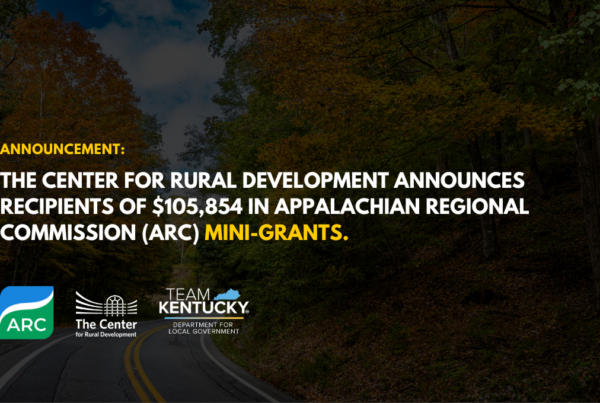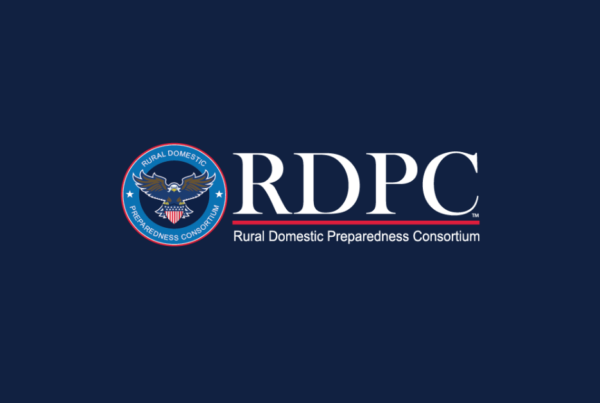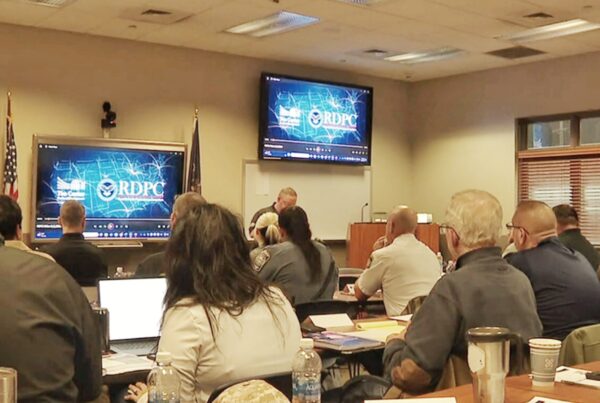Kentuckians are utilizing technology more than ever as we turn to virtual methods of interacting with others in our daily lives. As our need for internet connectivity grows it is reassuring to know there are many exciting initiatives that are in motion to improve broadband across the state. During the recent 2020 SOAR Summit, a panel of broadband champions discussed what is currently taking place in our state.
Lonnie Lawson, President & CEO of The Center for Rural Development (The Center), joined Jamie Link, Executive Director of Kentucky Communications Network Authority (KCNA), and David Flessas, CEO of OpenFiber Kentucky.
Link announced that 99% of the fiber construction of KentuckyWired is complete and KCNA is now working to complete structures and equipment and will then be completing testing. “We will turn up rings as quickly as we possibly can. We have currently turned up what we call ring 1A,” he said. “We have currently migrated more than 137 state agencies over to the KentuckyWired network. Our next focus is to turn up service in Ring 1B which is Eastern Kentucky, Ring 2 which is Southeastern Kentucky, Ring 3 which is Southcentral Kentucky,” Link added.
“We will be responsible for migrating the state office locations in those areas that serve the constituents across the commonwealth. Then we’ll work closely with David and OpenFiber Kentucky to work on the last-mile connectivity,” Link explained. He also pointed out that KCNA is currently working with the Education Workforce Development Cabinet, The Kentucky Department of Education and several other partners to develop a map to identify the most critical needs for service across the state. “Our goal right now is to map as quickly as possible where the most critical needs are and then we’ll work with local Internet Service Providers (ISPs), local governments, and local school districts to determine the best place to deploy hotspots,” he explained. “While on a parallel path we continue to work on the long-term solutions for more permanent service,” Link added. He explained that KCNA is also working with vital customers like health departments, and working with OpenFiber Kentucky to start building relationships and getting service out to commercial customers and residential customers quickly.
Lawson explained the steps that The Center is taking to enable last-mile services as well. “We’ve been at the forefront of trying to bring high-speed high-capacity broadband to Eastern Kentucky for many years now. We’re working in close cooperation with the Commonwealth of Kentucky. In addition to working with the Appalachian Regional Commission and providing funding for the build out of Ring 2 in Southeastern Kentucky, we’ve developed programs now that will actually help speed up the access to last-mile,” Lawson said.
The Center has developed specific programs including the Technology Assistance Program that enables communities who want to find the right model for broadband in their area. Through the program, communities can explore options such as community owned infrastructure and build outs to homes, businesses, and schools. “We have funding that will allow them to do feasibility studies. They can hire engineers that can help design the maps and what the routes might look like. They can work with all sorts of subject matter experts to help them make informed decisions,” Lawson added. He also explained that The Center recently put out an RFP for technical assistance experts to aid in these efforts.
“Another piece that we are looking at is where we can locate CenterLinks Access Nodes throughout our region,” Lawson mentioned. In areas of population where businesses or lots of different users of broadband need access, The Center can help,” he added.
Panel Moderator, Richard Taylor, Vice President of The Center, added that “Centerlink Access Nodes are designed to extend that middle-mile even closer to the communities, so we have plans for many of those in conjunction with David and Jamie, whether it’s on the state government side or on the commercial side, to deploy those out so that there are additional access points.”
Lawson added “We want to try to get as many different locations that we can for folks to have the opportunity to hook into that network.” Explaining further Lawson said, “We have partnered up with a company called GEO Partners that actually does crowd source mapping.” GEO Partners provides citizens with a way to document their current internet access. “If you are at your home, you type in the address where you are, and it will show the actual speed that you have in your location,” Lawson explained. “We can address it when we know what the actual lay of the land is,” Lawson added.
Flessas further expanded upon the idea. “It’s one thing to say there’s coverage in a particular county. It’s another to know very specifically on a house-by-house basis where that coverage exists, how far off the freeway the coverage exists, if it exists over the next ridge or in the next holler,” he explained. “I think next-gen mapping gets us to a measurement that is actionable and allows us to identify where the highest priority pain points are,” Flessas said.
The KentuckyWired project is an open access infrastructure meaning any ISP or local provider can gain access to the network, which is a first in the nation. Many local ISPs, especially those in Eastern Kentucky, will benefit from the large internet access feed. Even those who have adequate connectivity today will benefit from having carrier diversity.
Link shared that in some areas where broadband had been sparse or nonexistent, new opportunities had been created. “It may incentivize entrepreneurship or it may incentivize cooperative agreements between counties or various companies to deploy service. Obviously, there’s an economic equation that has to be addressed, and that’s where the affordability comes in because I think one of the goals behind the KentuckyWired project was for the commonwealth to install this middle-mile network to provide that basic infrastructure from which the local providers can then expand service out into their communities and their counties. So, we certainly want to encourage everyone to communicate with your local government and your local ISPs that you currently have.”
Link explained that “One of the key tenants of this project from Congressman Rogers and Governor Beshear is that there is a public purpose to this project.” He further explained “The goal was to bring service all across the state, and particularly to the unserved and underserved areas of our state. So, we will look for every option we can, of course working with The Center for Rural Development, the Appalachian Regional Commission, the USDA Rural Development, we will look for various funding sources that we might be able to find that can help proliferate that last-mile expansion. Everything is on the table right now because that need is so critical in so many different areas, we want to explore every option we have available to us.”
Lawson shared his excitement about creating new opportunities in rural areas. “Because the middle-mile infrastructure is built, and because we’re building into some of the communities, there are some additional providers that are looking at expanding their footprint, just because they don’t have the expense they would have to had to build it from scratch,” Lawson said.
Flessas shared information about actions OpenFiber Kentucky is taking part in. “We are already in communication with a number of communities who are trying to work through their options. Some are pretty well downstream on thinking about how they’re going to approach that last-mile solution. Others are still, I would say, in the brainstorming stage. We’re happy to have both those conversations. Were happy to field, and in fact, solicit those sorts of inquires so we can start talking specifics as we get closer to end service,” he said. “We are providing the middle-mile. We are looking to interconnect and to connect with whatever the community solution is. There is a portfolio of five or six different community solutions, and we are working through our best efforts and the best way we can connect with those communities,” Flessas explained.
Link echoed the sentiment on behalf of KCNA and KentuckyWired. “We will help anyone we can to gain connectivity. We’ll work with David and OpenFiber to help identify what the availability is in that area. Perhaps with this new infrastructure in place it becomes more economically feasible for current providers, or perhaps if there’s no provider in an area, for a provider to start up and start providing service to citizens of that area. Feel free to contact us,” he said. “We’ll make every effort to address your questions and your needs,” Link added.
Lawson also shared additional information about how The Center can provide assistance. “We want to make certain that folks all throughout the entire region are aware that they can get service,” he said. He then provided examples of current projects. “We did a feasibility study project in Pike County. The five counties that make up the Pine Mountain Industrial Development Authority which are Bell, Harlan, Knox, Letcher, and Whitley, we’ve put some funding toward that one to do a feasibility study. We’re working with Morehead and Rowan County on a needs assessment and a feasibility study. We’re working with Elkhorn City on a feasibility study. We have a new installation in Powell County at Slade, a last-mile installation. We’re working with the Valley Oak Technology Park in Pulaski County to try to expand service. And we’ve actually done training, fiber splicing schools and so forth,” Lawson said. “Any of these services that you need in your community, please reach out to us. We want to make sure that we help you. We want to do everything we can to make you successful in your home communities,” Lawson added. For more information about The Center’s various broadband initiatives contact The Center’s Broadband Technology Liaison, Scott Surber by email or phone at: ssurber@centertech.com or 606-677-6000.





